This was published 1 year ago
How this director plans to keep Planet of the Apes one of the most enduring franchises
The first Planet of the Apes movie hit screens in 1968. Kingdom of the Planet of the Apes aims to extend the dynasty a little further.
By Karl Quinn
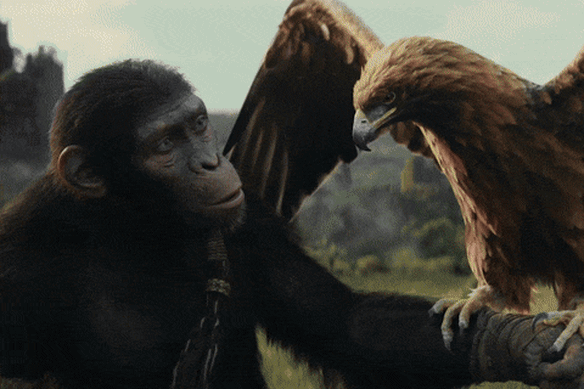
Planet of the Apes through the ages: Charlton Heston and Kim Hunter in Planet of the Apes (1968); Owen Teague in Kingdom of the Planet of the Apes (2024); Battle for the Planet of the Apes (1963); Helena Bonham Carter in Planet of the Apes (2001); and Andy Serkis as Caesar in Dawn of the Planet of the Apes (2014).
If making any movie is risky, rebooting the Planet of the Apes franchise (again) must represent a particularly hairy leap into the unknown for everyone involved.
“The sheer process of putting these movies together is overwhelming,” says Wes Ball, creator of the Maze Runner franchise and the man entrusted by Disney with breathing fresh life into a property that has seen many evolutions since 1968 (five movies in the first run, a live-action TV series, an animated TV series, a Tim Burton remake of the first film, and a reboot trilogy). “To be honest, I didn’t appreciate going in how difficult it is.”
The first film – starring Charlton Heston as an astronaut who thinks he’s travelled to a distant planet, only to realise in the final frames he has, in fact, travelled forward in time to his own – relied on make-up so advanced for its time that its designer was given an honorary Academy Award.
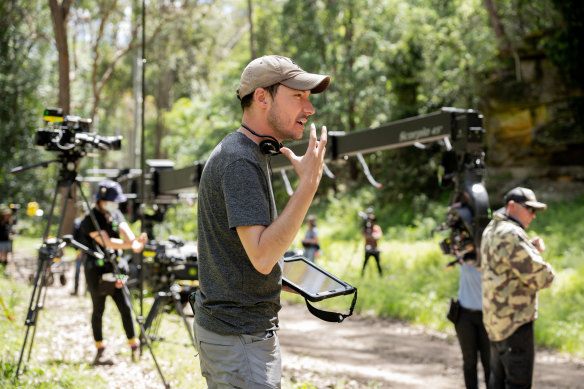
Director Wes Ball on the set of the film, which was shot just outside Sydney in 2023.Credit: Disney
The latest film is all about the VFX magic wrought by New Zealand effects house Weta (Lord of the Rings, King Kong, Avatar), using motion-capture footage of actors in bodysuits, faces covered in dots, with a tiny rig mounted on their heads to record their every twitch and grimace.
“Everywhere they go, there’s this freakin’ camera, so in my close-ups half their face is covered by a f---ing camera,” says Ball. “That’s the necessary process of it all.”
Well, that and a lot of micro-tweaking of digital details, to make that fur look real, those expressions believable, that movement – carried out by human actors and then rendered by VFX artists into apelike form – convincingly lifelike.
Generally speaking, Ball likes to shoot on the run, to allow space for serendipitous moments on set to emerge. But a movie like this, in which he’d have to shoot a landscape with his mocap (motion capture) actor in it, then again without the actor so the two might be seamlessly merged in the editing suite, demands enormous rigour in the planning, and leaves little room to manoeuvre later.
“Because of the time it takes to put this stuff together, you have to choose the take you want to use six, seven, eight months in advance,” Ball says. “You’re basically creating a jigsaw puzzle, but you’re doing it piece by piece all on its own, and you’re carving that shape right there, so it fits into this shape over here, and they’re all separate from each other until the last four weeks, when all those puzzles come together and you hope they fit.
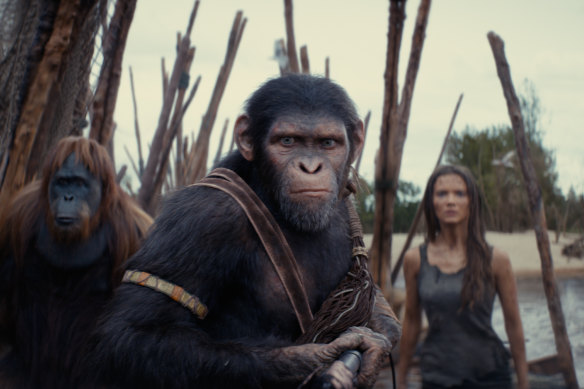
Raka (played by Peter Macon), Noa (played by Owen Teague) and Freya Allan as Nova in Kingdom of the Planet of the Apes.
“It’s wild trying to create something that is real and authentic when it is such a process of craft.”
We’re talking in the final weeks of Ball’s near five-year journey to making the film, a period that saw original studio Fox bought by Disney, the disruptions of COVID, and the decision to shoot the film in Australia (almost all of it on location, outside Sydney). He’s still in the thick of that final edit, but he’s confident what he’s made effectively links the first iteration of the saga (based on French writer Pierre Boulle’s 1963 novel) with the Matt Reeves trilogy that began with Rise of the Planet of the Apes in 2011, and hopefully lays the groundwork for yet more films to come.
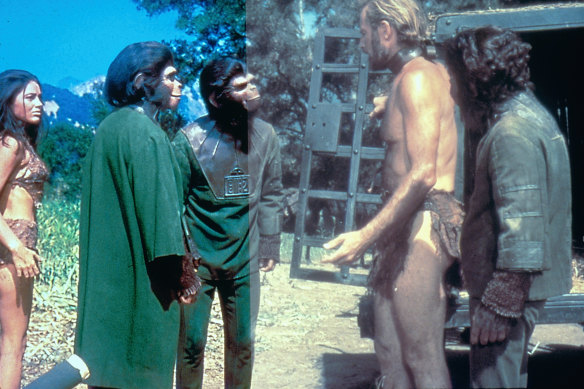
(From left) Linda Harrison, Kim Hunter, Roddy McDowell and Charlton Heston in the original Planet of the Apes (1968).
“It’s very much a continuation, but when I was first brought into this thing, I said I wasn’t interested in making a part four; there’s just no reason to do that,” he says. “I like to say that we’re basically a sequel and a prequel.
“All of the movies have been a little loose with the canon essentially, with each other, but we tried to find that sweet spot where we kind of belong to the previous Caesar universe [of the Reeves trilogy], but we’re also seeing the established ideas that were in that ’68 version. We’re trying to be a little bit of both here.”
For my money, they’ve succeeded. Kingdom is rich with nods to the original – including a thrilling hunt scene complete with echoes of Jerry Goldsmith’s percussive score – while building on the visual legacy, and incredible effects, of the later films.
And in the relationship between the chimpanzee hero Noa (played, somewhere beneath all that digital trickery, by Owen Teague) and the human Nova (Freya Allen), there’s a thread that runs through the entire series – even including the Burton remake of 2001.
There is, however, no hint of the interspecies infatuation that flickered between Helena Bonham Carter’s ape and Mark Wahlberg’s human in that one.
“There were a lot of jokes about that on set,” says Teague. “But don’t worry, it never happens.”
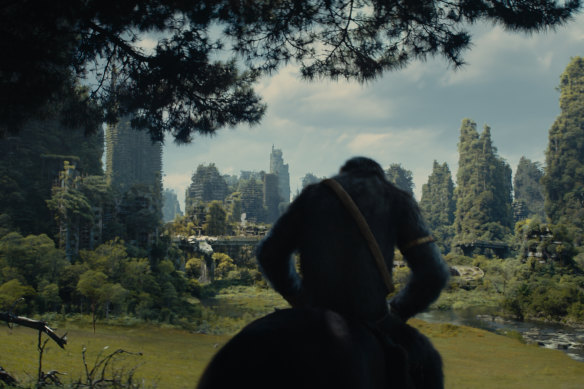
The setting for the story is southern California, with the ruins of Los Angeles overtaken by nature.Credit: Disney
Plenty of actors don’t enjoy working with motion capture, but Teague considers the seven months he spent shooting the film one of the best experiences of his professional life.
“It reminded me why I became an actor, which is to be something else entirely,” he says. “They talk about your body being your tool, which is kind of pretentious, but it’s true. This kind of performance really makes it clear just how much of a full body thing being somebody else is.”
Of course, Noa isn’t just a regular chimpanzee – he can speak, thanks to the man-made virus that has given apes a leg-up and humans a knock down on the evolutionary ladder in the Reeves canon. And he can think, albeit a little sluggishly at the outset.
“Really, at its heart, it’s a coming-of-age story,” Teague says. “Noa has to become an adult and a leader and figure out who he is and what he’s capable of.
“He starts out very naive – he doesn’t know anything about the outside world, he’s got a lot of pressure from his father, and he doesn’t think he can live up to what his father expects from him. When I pictured Noa, I pictured a chimpanzee, but I also pictured myself. There was a merging.”
So much so, he says, that in the final two weeks of production, “I started having dreams as an ape. I would have these dreams about making the movie, or about things Noa was going through, and I would look at my hands and they were ape hands.
“It didn’t feel weird to me, it wasn’t like I was putting on some thing. It was just like, ‘Yeah, this is how I am.’”
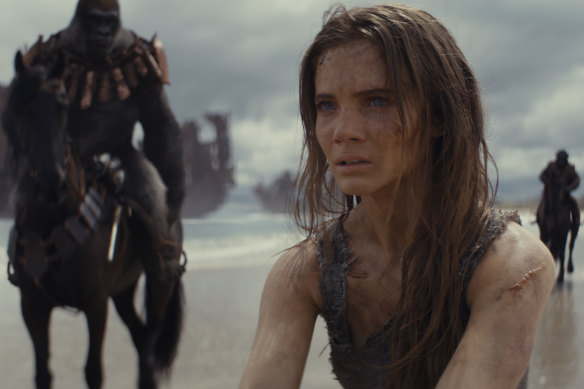
English actor Freya Allen plays Nova, a mysterious human who suddenly arrives in the world of the apes.Credit: Disney
As Nova, the mysterious human who enters the world of the apes a third of the way through the movie, Freya Allen has the rare privilege of actually showing her face on screen. But she also had to learn how to move like an animal because when we first meet her, she is cowed, hungry and alone – a lowly creature to be pitied if not scorned by the apes.
“The physical side of it was very interesting,” she says. “It was mainly me trying to be as animalistic as I could, really trying to embody that, which came very naturally to me because I spent my childhood pretending to be animals.”
Really? What was your favourite?
“I loved being a dog or a horse. I’m very, very fast at running on all fours – it’s really a random skill, but it came in very handy for this film. Owen and I did a race at the very end of the shoot, where he had his arm extensions on, and I beat him.”
So, in that respect at least, humanity triumphs over the apes.
“It’s the little wins in life…”
When Nova first meets Noa, she is not sure if she can trust him, or he her. The relationship between them is, Allen suggests, “very symbolic … they’re holding up a mirror to each other and seeing another perspective, seeing through another creature’s eyes.”
The world the apes rule is more lush and green than the ones the humans lorded it over, so at first the viewer might wonder if “maybe it’s better if the apes have the planet”.
“But,” Allen adds, “you begin to see that as they evolve, the more likely they are to follow down the footsteps of humans. It definitely raises that debate, you know.”
Kingdom of the Planet of the Apes is released in cinemas on May 9.
Contact the author at kquinn@theage.com.au, follow him on Facebook at karlquinnjournalist and on Twitter @karlkwin, and read more of his work here.
Find out the next TV, streaming series and movies to add to your must-sees. Get The Watchlist delivered every Thursday.